
A hot spring, hydrothermal spring, or geothermal spring is a spring produced by the emergence of geothermally heated groundwater onto the surface of the Earth. The groundwater is heated either by shallow bodies of magma or by circulation through faults to hot rock deep in the Earth's crust.

Alvin (DSV-2) is a crewed deep-ocean research submersible owned by the United States Navy and operated by the Woods Hole Oceanographic Institution (WHOI) of Woods Hole, Massachusetts. The original vehicle was built by General Mills' Electronics Group in Minneapolis, Minnesota. Named to honor the prime mover and creative inspiration for the vehicle, Allyn Vine, Alvin was commissioned on June 5, 1964.

Robert Duane Ballard is an American retired Navy officer and a professor of oceanography at the University of Rhode Island who is noted for his work in underwater archaeology and marine geology. He is best known by the general public for the discoveries of the wrecks of the RMS Titanic in 1985, the battleship Bismarck in 1989, and the aircraft carrier USS Yorktown in 1998. He discovered the wreck of John F. Kennedy's PT-109 in 2002 and visited Biuku Gasa and Eroni Kumana, who saved its crew.
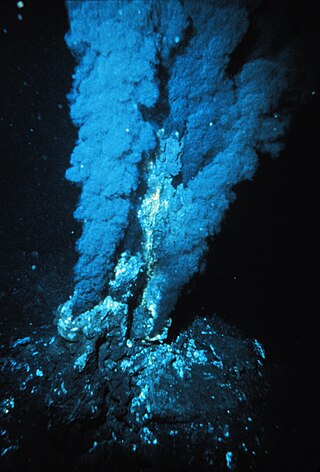
Hydrothermal vents are fissures on the seabed from which geothermally heated water discharges. They are commonly found near volcanically active places, areas where tectonic plates are moving apart at mid-ocean ridges, ocean basins, and hotspots. The dispersal of hydrothermal fluids throughout the global ocean at active vent sites creates hydrothermal plumes. Hydrothermal deposits are rocks and mineral ore deposits formed by the action of hydrothermal vents.

The seabed is the bottom of the ocean. All floors of the ocean are known as 'seabeds'.
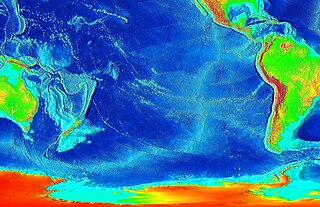
The East Pacific Rise (EPR) is a mid-ocean rise, at a divergent tectonic plate boundary, located along the floor of the Pacific Ocean. It separates the Pacific plate to the west from the North American plate, the Rivera plate, the Cocos plate, the Nazca plate, and the Antarctic plate. It runs south from the Gulf of California in the Salton Sea basin in Southern California to a point near 55°S130°W, where it joins the Pacific-Antarctic Ridge (PAR) trending west-south-west towards Antarctica, near New Zealand. Much of the rise lies about 3,200 km (2,000 mi) off the South American coast and reaches a height about 1,800–2,700 m (5,900–8,900 ft) above the surrounding seafloor.

The Lost City Hydrothermal Field, often referred to simply as Lost City, is an area of marine alkaline hydrothermal vents located on the Atlantis Massif at the intersection between the Mid-Atlantic Ridge and the Atlantis Transform Fault, in the Atlantic Ocean. It is a long-lived site of active and inactive ultramafic-hosted serpentinization, abiotically producing many simple molecules such as methane and hydrogen which are fundamental to microbial life. As such it has generated scientific interest as a prime location for investigating the origin of life on Earth and other planets similar to it.
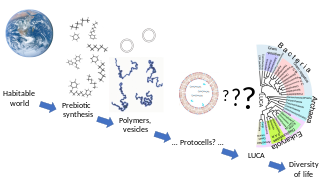
Abiogenesis is the natural process by which life arises from non-living matter, such as simple organic compounds. The prevailing scientific hypothesis is that the transition from non-living to living entities on Earth was not a single event, but a process of increasing complexity involving the formation of a habitable planet, the prebiotic synthesis of organic molecules, molecular self-replication, self-assembly, autocatalysis, and the emergence of cell membranes. The transition from non-life to life has never been observed experimentally, but many proposals have been made for different stages of the process.

The Endeavour Hydrothermal Vents are a group of hydrothermal vents in the north-eastern Pacific Ocean, located 260 kilometres (160 mi) southwest of Vancouver Island, British Columbia, Canada. The vent field lies 2,250 metres (7,380 ft) below sea level on the northern Endeavour segment of the Juan de Fuca Ridge. In 1982, dredged sulfide samples were recovered from the area covered in small tube worms and prompted a return to the vent field in August 1984, where the active vent field was confirmed by HOV Alvin on leg 10 of cruise AII-112.
Cindy Lee Van Dover is the Harvey Smith Professor of Biological Oceanography and chair of the Division of Marine Science and Conservation at Duke University. She is also the director of the Duke University Marine Laboratory. Her primary area of research is oceanography, but she also studies biodiversity, biogeochemistry, conservation biology, ecology, and marine science.

The Beebe Hydrothermal Vent Field is the world's deepest known hydrothermal vent site and is located just south of Grand Cayman in the Caribbean, on the north side of the Mid-Cayman Spreading Centre in the Cayman Trough. Approximately 24 kilometres (15 mi) south of Beebe is the Von Damm Vent Field.
Matthew Schrenk is an associate professor in geomicrobiology at Michigan State University. His research focuses on the diversity, distribution, and activities of microorganisms in the deep subsurface biosphere. His work couples molecular biological approaches and geochemical analyses to investigate microbial ecosystems. Schrenk investigates high pH environments fueled by underground serpentinization reactions between water and certain rock types and hydrothermal vent systems along the ocean floor that are driven by volcanic activity.
Kathleen (Kathy) Crane is an American marine geologist, best known for her contributions to the discovery of hydrothermal vents on the Galápagos Rift along the East Pacific Rise in the mid-1970s.
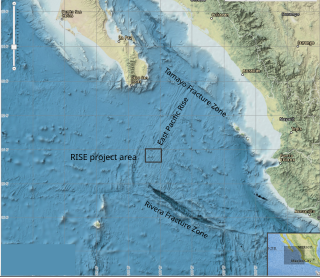
The RISE Project (Rivera Submersible Experiments) was a 1979 international marine research project which mapped and investigated seafloor spreading in the Pacific Ocean, at the crest of the East Pacific Rise (EPR) at 21° north latitude. Using a deep sea submersible (ALVIN) to search for hydrothermal activity at depths around 2600 meters, the project discovered a series of vents emitting dark mineral particles at extremely high temperatures which gave rise to the popular name, "black smokers". Biologic communities found at 21° N vents, based on chemosynthesis and similar to those found at the Galapagos spreading center, established that these communities are not unique. Discovery of a deep-sea ecosystem not based on sunlight spurred theories of the origin of life on Earth.

Project FAMOUS was the first-ever marine scientific exploration by manned submersibles of a diverging tectonic plate boundary on a mid-ocean ridge. It took place between 1971 and 1974, with a multi-national team of scientists concentrating numerous underwater surveys on an area of the Mid-Atlantic Ridge about 700 kilometers west of the Azores. By deploying new methods and specialized equipment, scientists were able to look at the sea floor in far greater detail than ever before. The project succeeded in defining the main mechanisms of creation of the median rift valley on the Mid-Atlantic Ridge, and in locating and mapping the zone of oceanic crustal accretion.
Karen Louise Von Damm was an American marine geochemist who studied underseas hydrothermal vent systems. Her work on black smoker hot springs after they were first discovered on the mid-ocean ridge in 1979 significantly advanced understanding of how vent fluids acquire their chemical composition and how those chemicals support biological communities. An area of hydrothermal vents located just south of Grand Cayman in the Caribbean was named the Von Damm Vent Field in her honor.
John A. Baross is an American marine microbiologist and professor of oceanography and astrobiology at the University of Washington who has made significant discoveries in the field of the microbial ecology of hydrothermal vents and the physiology of thermophilic bacteria and archaea.
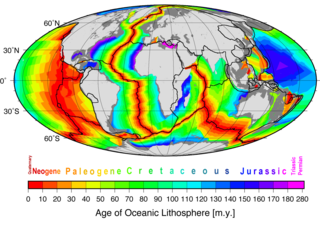
Marine geophysics is the scientific discipline that employs methods of geophysics to study the world's ocean basins and continental margins, particularly the solid earth beneath the ocean. It shares objectives with marine geology, which uses sedimentological, paleontological, and geochemical methods. Marine geophysical data analyses led to the theories of seafloor spreading and plate tectonics.
Rachel Haymon is a marine geologist known for her work linking geological and biological processes occurring at deep-sea hydrothermal vents. In 2005 she was elected a fellow of the Geological Society of America.
Tjeerd Hendrik "Jerry" van Andel was a Dutch geologist, oceanographer and geoarchaeologist. Over a long career he worked in both industry and academia, and his work was recognised with the award of a number of medals and distinguished fellowships. He led the first expedition and dive with the crewed submersible Alvin that discovered life around deep hydrothermal vents in 1977.














